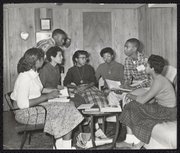LITTLE ROCK — There is no blood or spittle on the black skirt set, the honor roll report card and the 1960 diploma from Little Rock’s Central High School.
These ordinary markers from a girlhood education, recently donated to the Smithsonian Institution’s National Museum of African American History and Culture, bear no obvious testament to their power to rend a nation.
But in the middle of the 20th century, as the country reckoned with its oldest business, battles over race and citizenship were fought by people who placed their highest stakes in ordinary places - lunch counters, water fountains, schools.
For Carlotta Walls LaNier, the youngest of the “Little Rock Nine,” who in 1957, under escort from the Army’s 101st Airborne Division, became the first black students to desegregate Central High, these items are artifacts of assertion.
Sept. 25 was the 55th anniversary of the first day the Nine were allowed to stay at Central High School. Their first attempt to walk through the school doors was blocked by National Guard troops called by Arkansas Gov. Orval Faubus. Their second try was cut short because of the threat of mob violence.
Faubus said he called out the National Guard “to maintain ... the peace and good order of the community” and directed the Guard to prevent nine black students from entering the all-white school, notwithstanding a court approved desegregation plan.
LaNier wore her new dress on both attempts to enter the school. At a small ceremony the museum’s Capital Gallery Building offices, she donated it and the other items to its collection.
She wants people “to know about the Little Rock Nine, because our young kids are sitting in a classroom with people who don’t look like them, and they think this is the way it’s always been - but no, we had a separate school situation,” says LaNier, 69, who now lives in Denver. “I think this is a learning tool for any and everybody who walks through that museum.”
“Part of what moves me about these artifacts is that they are so simple,” says the museum’s founding director, Lonnie G. Bunch. The Little Rock Nine are particularly important to “the notion of children changing society and bearing the sorts of searing pressures of that change that really inspired more generations,” he says. “When you see the pictures, the hatred and the venom, it makes you admire so much these young people who went through this.”
ADDRESSING THE PAST
LaNier’s mother used to make all her clothes, but for her first day of high school, “my uncle wanted me to have a store-bought dress, and he gave me the money.”As a 14-year-old, LaNier didn’t know that she was about to make history. A good student, she thought Central High - which, like all-white schools around the nation, was under a Supreme Court ruling to desegregate - offered great educational opportunities,and thought it important to look good.
“We grew up knowing that other people thought less of you, so you were always on guard about being representative of your family, your race, your community, your church,” LaNier says. “You didn’t want to let anyone down.”
On Sept. 20, 1957, Faubus removed the guardsmen in compliance with the order of a federal judge.When the black students went to Central on Sept. 23, a violent crowd gathered. The students were removed for their protection. President Dwight D. Eisenhower then federalized the National Guard and sent 101st Airborne Division troops to the school the next day to enforce the school’s integration. The black students attended school the rest of the year under federal protection.
LaNier hadn’t known that getting into the school was the first step in a years-long, deeply painful ordeal. She calls her first semester report card meaningful because with all “that was happening to us - being pushed down steps, spat upon, people walking on my heels - I still made the honor roll.” Some whites said black kids couldn’t get good grades, she says, “and this just shot all of that down.”
Only three of the Nine participated in graduation ceremonies, and LaNier, who was the only girl, calls the third artifact, her diploma, a “vindication.”
In the summer of 1958, before classes were scheduled to open, the state Legislature approved Faubus’ package of bills, including what became Act 4, which authorized the governor, by proclamation, to close any or all public schools within a district facing forced desegregation, pending a referendum within 30 days to allow voters to decide whether to allow integration. On Sept. 27, 1958, Little Rock voters opposed integrating - 19,470 to 7,561 votes.
While segregationists opened their own whites-only school, some students simply sat out, while the families of La-Nier and others scraped together money for correspondence courses and textbooks until the courts forced the high schools to reopen the following year.
LaNier’s home was bombed while she, her mother and little sisters were inside. After police officials first accused her father, a childhood friend she believes was innocent was jailed in the crime. LaNier says her diploma meant that “I accomplished what I started.” And it belongs to everyone who helped her along the way.
Senior curator Bill Pretzer says the museum, scheduled to open in 2015, is planning its inaugural exhibitions. “The Little Rock Nine was an absolutely critical event in the civil rights era, and we absolutely wanted to represent it in some fashion.”
LaNier is the only one of the Little Rock Nine to donate memorabilia so far, although others are considering it, Pretzer says. In addition to the three items, she’s donating 15 boxes of material: programs from commemorations, and letters, including missives from President Eisenhower in 1957 and President Bill Clinton in 1999, when the Little Rock Nine were awarded the Congressional Gold Medal.
At the 100th anniversary of the Little Rock Nine’s first day at Central High, “someone will be looking back and say how did they think about that” 50 years later, Pretzer says. It’s rare to have so much material, but LaNier “acted like her own historian, and curator of the history she had made,” he adds.
LaNier credits her mother with keeping the dress, and she says that with all her Little Rock Nine items, I always “felt like somewhere down the line, it needs to go somewhere. That it’s going to be of some use.”
After LaNier finished high school, the family moved away,eventually settling in Denver. LaNier, who graduated from what is now the University of Northern Colorado, worked for the YWCA before founding her own real-estate brokerage firm.
Her memoir, A Mighty Long Way, My Journey to Justice at Little Rock Central High School, was published in 2009. She speaks to student groups around the country about the importance of personal responsibility and about the most painful parts of the American story.
“We need to be open-minded and need to discuss issues without being adversarial,” she says, and she hopes she can help with that. She’d always thought history was about dead people. But “I’m standing before you, and yes, I’ve finally accepted the fact that I’m a part of history.” Information for this article was contributed by Kenneth Heard of the Arkansas Democrat-Gazette.
Style, Pages 27 on 11/06/2012


